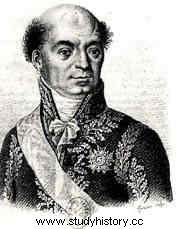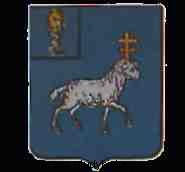May 31, 1754 (Granada) - December 25, 1818 (Paris)
-

- Pérignon, Catherine-Dominique, (marquis of)
Catherine-Dominique Marquis de Pérignon, May 31, 1754 (Grenade-sur-Garonne) - December 25, 1818 (Paris), Marshal of the Empire (1804).
From a wealthy family established in Languedoc (Grenade sur Garonne) since the 16th century and one branch of which was ennobled by the Capitoulat of the city of Toulouse in the 18th century, de Pérignon began a military career after good studies.
He obtained a commission as a second lieutenant in the corps of royal grenadiers in Guyenne. In 1780, he was aide-de-camp to the Comte de Preissac. The reform of Ségur leaving little possibility of advancement to the commoners and the minor nobility, he resigned from his functions and returned to his lands.
Returning for some time already to civilian life, with the maturity of the exercise and the years, he was not long in associating himself with the new order of things. He welcomed the events of 1789 with kindness and embraced their ideas.
He accepted the functions of justice of the peace of the canton of Montech. It was in the exercise of this new and popular magistracy that the voters of the department of Haute-Garonne came to take him to send him as their elected representative deputy to the Legislative Assembly in 1791.
He was then thirty-seven years old; he had served as an officer, he had sat as a judge; these precedents were to influence the rest of his life and to deprive him, whether in the camps or in business, of the character of his specialty. He sits in the Legislative on the right, is a member of the military committee, but resigns, at the first cry of war, to become lieutenant-colonel of infantry in the army of the Pyrénées-Orientales.
On July 17, 1793, in the battle of Thuir and Mas-de-Serre, his intrepidity played a large part in the successes of the French armies. He stood out in the battle of Truillas by the representatives of the people, and became colonel in 1793 then obtained the title of brigadier general in September.
Major General two months later on 3 Nivôse Year II, he won many successes. He had the glory of saving the place of Perpignan:in this affair he received a bayonet thrust in the thigh. He takes the Boulogne camp (1st 1794).
Winner at La Junquera (June 7), he commanded the center of the army on 28 Brumaire Year III, at the Battle of Montagne-Noire (November 17-20, 1794) against the Spaniards, where Dugommier died, killed at the head of the army in November 1794.
He succeeded him in command. The battle of Escola, the capture of the impregnable Rosebud and the town of Roses gloriously justified the choice made of him. He took Figuières but suffered a setback at Bascara on May 6, 1795.
He was elected by Haute-Garonne to the Council of Five Hundred. On 4 Messidor Year III, the Treaty of Basel reconciled France and Spain, and Pérignon, ambassador to Madrid, was charged with cementing the friendly relations that his victories had restored, and concluding an offensive-defensive alliance. Two years later, Vice-Admiral Truguet replaced him in this important post. This will be the Treaty of San-Idelfonse, in August 1796.
The Directory recalled him in 1797, following an affair he had with a royalist spy, he was placed on reform treatment. Returned to service in 1799, he was given command of the troops of Liguria. He went to resume his battle rank in the army of Italy.
He commanded the left wing at the Battle of Novi; his two divisions, under the orders of Generals Grouchy and Lemoine, guarded the valleys of the Bormida and the Tanaro. Pérignon defended the village of Pasturana and performed prodigies of valor; but, overwhelmed by numbers, he fell; covered with wounds, in the power of the enemy. He was taken prisoner (August 15, 1799).
It was not until Year IX that the Russians returned it to France. The winner of the battle of Marengo welcomed the intrepid and unfortunate soldier of Novi; but, already forty-seven years old, Pérignon could not take his place in this procession of young captains who crowded around the young hero.
Bonaparte had him appointed to the Senate (1801), vice-president of this assembly.
Drawn from the active army, Pérignon thus entered the legislative career by the first magistracy of the Republic.
The treaty of 26 Fructidor Year IV had left uncertainty regarding the limits of France and Spain on the side of the Pyrenees; Pérignon, who had signed this treaty, received, on 24 Fructidor, Year X, the mission of settling these difficulties, as extraordinary commissioner.
President of the electoral college of Haute-Garonne on 19 Ventôse year XII, on the following 16 Floréal he presented a deputation from the college to the First Consul, and thus ended his speech. He was very active there in the Senate in favor of the Consulate for life and the promulgation of the Empire.
Pérignon had been placed in possession of the senatory of Bordeaux by consular disposition dated Vendémiaire Year XII.
The day after his elevation to the Empire, Napoleon issued a decree (29 Floréal), which created fourteen Marshals of France, to whom were added, with the same title, four senators, among whom Pérignon, as having commanded in chief. Already old when he was appointed, Perignon's military career was behind him when he received his marshal's baton, from then on the rest of his career was essentially devoted to administrative tasks.
The Marshal Senator became, on 25 Prairial Year XIII, Grand Officer of the Legion of Honor and Grand Aigle me 13 Pluviôse Year XIII (1805).
Governor of Parma and Plaisance in 1806, he received in 1808 the order to go and take command of the French troops in the kingdom of Naples in replacement of General Jourdan, and the same year he was created grand dignitary of the Order of the Two Sicilies. The title of Count of the Empire (1808) had just been conferred on him. He did not leave Naples until the king declared himself against France.
He commands the Neapolitan army of Murat during his absences. He separated from Murat at the first signs of the prince's defection in 1813.
He will rally to Louis XVIII only after the resignation of Napoleon.
There was proof of zeal and condescension in this eager step, and then Count Pêrignon had adhered to the acts of the Senate; also the lieutenant-general of the kingdom appointed him commissioner of the king in the 1st military division, and royal ordinances of May 31, June 1 and 4, made him successively knight of Saint-Louis, president of the commission in charge of verifying the titles of the former officers of the army of emigrants, and finally peer of France.
Appointed Governor of the 10th Military Division in 1815, he sought in March, together with Baron de Vitrolles, to organize a plan of resistance against Napoleon in the South. He did not succeed and remained away from business during the Hundred Days and was struck off the list of marshals by the Emperor.
Reintegrated into the second Restoration, on January 10, 1816, he passed with the same title in the 1st military division, and received on May 3 following the cross of commander of the order of Saint-Louis, military governor of Paris, then marquis in 1817.
He had voted for death during the trial of Ney and died on December 25, 1818 in Paris covered with honors.
Pérignon's name appears on the Arc de Triomphe.
-

- Pérignon:Count-Senator's shield
